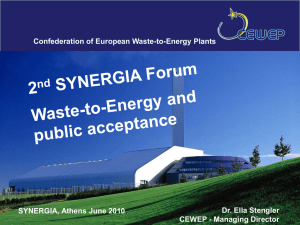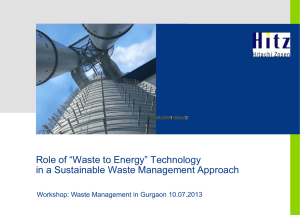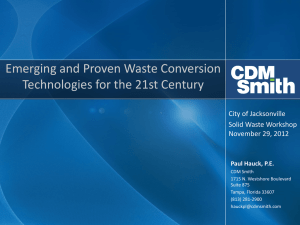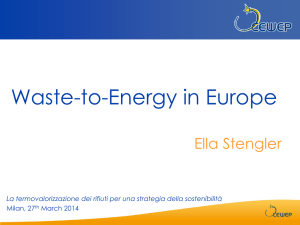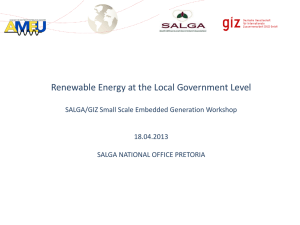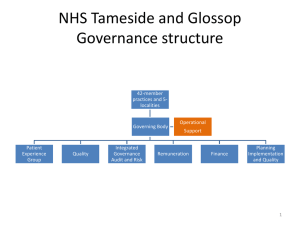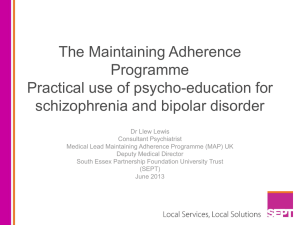Photos of WTE Plants - Waste-to-Energy Research and Technology
advertisement
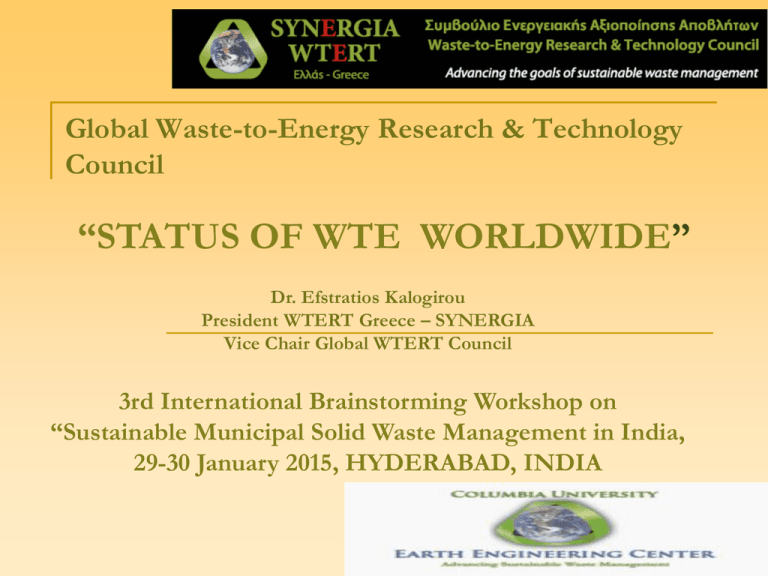
Global Waste-to-Energy Research & Technology Council “STATUS OF WTE WORLDWIDE” Dr. Efstratios Kalogirou President WTERT Greece – SYNERGIA Vice Chair Global WTERT Council 3rd International Brainstorming Workshop on “Sustainable Municipal Solid Waste Management in India, 29-30 January 2015, HYDERABAD, INDIA Mission of the Waste to Energy Research and Technology Council (WTERT) WTERT was formed in 2002 EEC/CU, to promote all means of sustainable waste management by maximizing the recovery of materials and energy and minimizing the environmental impacts, on the basis of the scientific knowledge of the effects of various waste treatment technologies worldwide. The accepted hierarchy of waste management dictates materials recovery followed by energy recovery (waste-to-energy) by means of thermal treatment, as used in more than 1000 WTE plants worldwide (460 in Europe, 90 in USA, and the rest in Asia and other parts of the world). WTERT-Greece, SYNERGIA www.wtert.gr 2 The WTERT Hierarchy of Sustainable Waste Management + 120 kWh electr./ton + 0.6 + Mw 600 el/ton kWh,el +100 kWh,el +0.1 MWhel/ton The Global WTERT Council (GWC) The Global WTERT Council has recently been formed. It will assist in the creation of new WTERT national organizations and coordinate the activities of existing ones in achieving the common goal: to identify the best available technologies for the treatment of various waste materials to conduct additional academic research as required to disseminate this information by means of publications, the multilingual WTERT web pages, and periodic meetings and conferences, at the national and international levels. GWC will consist of the heads of the national WTERT organizations. Its second meeting was held in conjunction with the next WTERT-U.S. biannual meeting at Columbia University (October 18-19, 2014). WTERT-Greece, SYNERGIA www.wtert.gr 4 WTERT Greece WTERT Greece – SYNERGIA The Waste-to-Energy Research and Technology Council (SYNERGIA, www.wtert.gr) was founded on July 2008 by the following founding members: The Earth Engineering Center of Columbia University, New York Members of the Thermodynamics and Transport Phenomena Laboratory, School of Chemical Engineering, National Technical University of Athens (N.T.U.A) Members of the Laboratory of Heat Transfer and Environmental Engineering, Department of Mechanical Engineering of the Aristotle University of Thessaloniki (A.U.TH.) WTERT-Greece, SYNERGIA www.wtert.gr 5 GLOBAL WTERT COUNCIL www.wtert.org www.mater.polimi.it /mater/ http://wtert.in www.wtert.co.uk www.wtert.ca www.wtert.eu www.wtert.cn www.wtert.com.br www.wtertuane.com. mx/ www.wtert.jp New Entries: France, Singapore www.wtert.gr 6 Recent Participations of GWC in Congresses worldwide 10 June 2010: 2nd SYNERGIA FORUM in Athens www.wtert.gr 7 Recent participations of GWC in Congresses worldwide 18-22 June 2012: 1st International Sustainable Waste Management Workshop in Athens, co-organised by EEC Columbia University, SYNERGIA and AIT www.wtert.gr 9 10 BAKU WTE PLANT AZERBAIJAN Technical Visits of GWC in WTE Plants BAKU, SWM seminar 2013 Presentation of GWC at Panama City WTE Seminar in Tsinghua University Meeting at sister organization Mater/Italy www.wtert.gr 12 International WTE Technical Visits Barcelona, Tersa WTE Plant WTE Seminar at Yonsei Univ. Korea Pudong (SHANGHAI, WTE Plant) Flue Gas Cleaning in Suzhou WTE Plant www.wtert.gr 13 Technical Visits of GWC in WTE Plants 25 – 26 February 2010: Acerra/Naples WTE Plant in Italy covering electricity needs for 230,000 families Naples WTE Plant WTERT-Greece, SYNERGIA www.wtert.gr 14 Estimated global disposition of urban post-recycling municipal solid wastes (total: 1.2 billion tons; 2012) • Thermal treatment (WTE): 200 mill. tons • Sanitary landfill, partial CH4 recovery: 200 mill. tons • Landfilled without CH4 recovery: >800 mill. tons Estimated land use for sanitary landfilling: 10 tons MSW/m2 GWC – Achievements New Renewable Energy Sources Law 3851/2010 regarding the electricity price from WTE 87,85€/MWh, for the biodegradable fraction of MSW. This way a very competitive gate fee is achieved, which will make WtE attractive for international investors Advising local decision makers in Brazil to apply law number 12.305/2010, which will establish WtE as a Renewable Energy Source. SYNERGIA, in cooperation with WTERT/US and WTERT/China advised the policy makers to change the dioxin/furan emissions limit to 0.1 ng/Nm3 (EU standards), helping the country develop state of the art WTE plants. www.wtert.gr 16 Waste-to-Energy in Europe Typical WTE Plant WTERT-Greece, SYNERGIA www.wtert.gr 17 Now available on www.wtert.org Reasons for dominance of grate combustion •Simplicity of operation •Very high plant availability •Low personnel requirement (<70 for a one-million tons/year plant) and ease of training of people in existing operating plants BAT issues coverage: Emission levels Waste input, storage, handling, pretreatment Combustion + operating conditions Flue Gas Treatment: design and operation Monitoring Energy efficiency Residues/Waste from incineration: treatment and disposal Waste Water Treatment: design and operation Emission levels Methods of Thermal Treatment Gasification: Very energy intensive, not available yet on a large commercial scale, untested in mixed municipal solid waste. Very few units of low capacities operational (more in Japan). Plasma gasification shows much more promise but lacks big references. Pyrolysis: Hasn’t been used efficiently in municipal solid waste (reference in tyres, etc.) Incineration: Proven, dominant, tested on a large scale (over 1000 units worldwide), efficient, waste management process www.wtert.gr 21 Europe www.wtert.gr 22 Waste-to-Energy in Europe Legislation • According to the European Union legislation for sanitary landfills 1999/31 only residues of waste management can be disposed to landfills, whereas by 2020 there will be a gradual reduction of the biodegradable fraction that is landfilled • According to the European Union directive 2000/76 (the emission limits of Waste to Energy plants are set). New Directive 2010/75 • On the 19th of November 2008 according to the EU directive 2008/98, WTE is upgraded in the hierarchy of Solid Waste Treatment in Europe. WTERT-Greece, SYNERGIA www.wtert.gr 23 Waste-to-Energy in Europe 24 In the E.U., recycling is excellently combined with waste to energy, whereas in countries where landfill is dominant, recycling and waste to energy are lagging behind www.wtert.gr 25 WTE Plants in Europe WTERT-Greece, SYNERGIA www.wtert.gr 26 International WTE PLANT, The case of BARCELONA Barcelona, Tersa WTE Plant with district heating & district cooling www.wtert.org 27 Energy recovery from “wastes”(waste-to energy or WTE) is equivalent to recycling (E.U.) Today, several countries such as Japan, Austria, Switzerland, Germany, the Netherlands, Korea and Singapore use WTE as the main process for treating post-recycling municipal solid wastes (MSW). There are only two options for managing postrecycling wastes: Sanitary landfill or thermal treatment (WTE) WTE advantages: • Conservation of land near cities • Energy recovery: 0.5 MWh/ton, over LFG recovery • Reduction of Greenhouse Gas (GHG) emissions: 0.5-1 ton CO2 per ton MSW (vs landfilling) • Esthetically more acceptable to communities; in fact only acceptable option in most developing countries. Waste-to-Energy as Renewable Energy Source • Waste-to-Energy will contribute in achieving the goals set by the European Union regarding the production of energy from Renewable Energy Sources, as the biodegradable part of the MSW is considered biomass (Directive 2009/28), thus R.E.S. • According to international practice Waste-to-Energy plants are considered R.E.S., according to the percentage of biomass contained in the incoming waste, i.e. its biodegradable fraction. The examples of several countries are shown in the following table (Data from CEWEP) www.wtert.gr 30 Waste-to-Energy Plants as R.E.S. Austria Belgium 50% Ireland 47,78% Italy 72% 51% Denmark 80% Netherlands 51% France 50% Switzerland 50% Germany 50% Portugal www.wtert.gr Calculated from empirical equation 31 Waste management in USA www.wtert.gr 32 ASIA www.wtert.gr 33 Waste-to-Energy in China China has become the fourth largest user of waste-to-energy (WTE), after E.U., Japan, and the U.S. WTERT-Greece, SYNERGIA www.wtert.gr 34 Technology of WTE in China Combustion system Number of plants Total capacity, tons/day Capacity distribution Stoker grate, imported Stoker grate, domestic Circulating Fluidized Bed(CFB) 56 20 37 47,585 12,885 31,920 50% 17% Total 113 92,390 www.wtert.gr 33% 100% 35 MSW Composition Organic Paper Plastic Glass Metal Textile Wood Ash China (2003) 52.6 6.9 7.3 1.6 0.5 4.7 6.9 19.2 USA (2005) 25.0 34.0 12.0 5.0 8.0 - - - France (2005) 32.0 20.0 9.0 10.0 3.0 - - - Australia (2005) 47.0 23.0 4.0 7.0 5.0 - - - Features High organic content High moisture content Low heating value WTE Number & Capacity 2001-2010 110 average capacity 100 700 90 600 80 500 70 400 60 plants number Average treatment capacity (tons/day) plants number 800 Increase in number 300 50 200 Enlarge in capacity 100 40 0 30 2001 2002 2003 2004 2005 2006 Year 2007 2008 2009 2010 WTE Tendency Renewable energy law and policy promote WTE electricity selling price (2007) : WTE = fossil fuel power plant + 0.25 ¥RMB Increased MSW capacity for WTE plant: 8001000 t/d (under design and construction) Increased incineration proportion to 35% by the end of 2016, with 48% in eastern region Trends in MSW treatment in the Republic of Korea (1989 – 2010) Energy recovery by combustion has increased from 2% (0.5 million tons) to 20% (3.8 million tons). Recycling/composting has also increased from 3% (0.8 million tons) to 61% (11.4 million tons) Landfilling has been drastically reduced from 94% (26.8 million tons) to 19% (3.5 million tons). WTERT-Greece, SYNERGIA www.wtert.gr 39 Waste Incineration Plants in the Republic of Korea 35 large incinerators (in red symbols), mostly using grate-type furnaces Heat supply 4.4 million MWh and electricity generation 0.2 million MWh WTERT-Greece, SYNERGIA www.wtert.gr 40 Waste Incineration Plants in the Republic of Korea WTERT-Korea sister organization is being developed under the leadership of Prof. Yong-Chil Seo of Yonsei University, Republic of Korea. http://www. wtert.kr 700 TPD Phuket Waste Incineration Plant 42 REF : http://www.pjt.co.th/index_th.asp 700 TPD Phuket Waste Incineration Plant Plant Location : Phuket City Municipality Capacity : 2 x 350 TPD with 14 MWe (Turbine Generator Rated) Technology : Stoker Incinerator + Steam Turbine-Generator + SDR + Bag Filter Contract : BOT for 15 yr and can re-contract for another15 yr 43 REF : http://www.pjt.co.th/index_th.asp Japan: Leader in use of older and newer technologies Moving grate: 84% No. of plants Total tons per day Average tons/day % of Japan WTE capacity Martin reverse acting grate (66 plants) 66 71,500 1083 62% JFE Volund grate (54 plants) 54 10,100 187 9% Martin horizontal grate (14 plants) 14 7,454 532 7% Nippon Steel Direct melting (28 plants) 28 6,200 221 5% JFE Hyper Grate (17 plants) 17 4,700 276 4% Rotary kiln (15 plants) 15 2,500 167 2% 7 1,980 283 2% 15 1,800 120 2% 8 1,700 213 1% 14 1,700 121 1% Hitachi Zosen fluid bed (8 plants) 8 1,380 173 1% JFE fluid bed (sludge & MSW; 9 plants) 9 1,300 144 1% All other Direct Melting (9 plants) 9 900 100 1% Fisia Babcock grate (2 forward, 1 roller) 3 710 237 1% 43 690 16 1% 310 114,614 JFE Thermoselect (gasification; 7 plants) All other fluid bed (15 plants) Ebara fluid bed (8 plants) JFE Direct Melting (shaft furnace, 14 plants) Babcock & Wilcox (43 plants) Total Total tons/year (330 days, 24 hour operation) 37,822,620 100% Emission levels in Waste to Energy Emissions from the Brescia plant, Italy All units are in mg/Nm3 The values correspond to dry air, normal conditions, 11% O2 Plant authorizatio n limits 1993 Design Plant limits 1994 European Union Limits 2000 Actual Operating Data 2005 Particulate matter 10 3 10 0,4 Sulphur Dioxide 150 40 50 6,5 Nitrous Oxides (NOx) 200 100 200 <80 Hydrochloric Acid (HCl) 30 20 10 3,5 Hydrofluoric Acid (HF) 1 1 1 0,1 Carbon Monoxide 100 40 50 15 Heavy Metals 2 0,5 0,5 0,01 Cadmium (Cd) 0,1 0,02 0,05 0,002 Merucy (Hg) 0,1 0,02 0,05 0,002 Polycyclic Aromatic Hydrocarbon (PAH) 0,05 0,01 Dioxin (TCDD Teq) 0,1 0,1 WTERT-Greece, SYNERGIA www.wtert.gr 0,00001 0,1 0,002 45 Comparison of Dioxin emission Data: Prof. Berd Bilitewski Modern Waste incineration plant: 1 0,01 ng/m³ Hazardous waste incineration plant: 1 0,01 ng/m³ 100 1,00 ng/m³ 1000 10,00 ng/m³ 10.000 100,00 ng/m³ 100.000 1000,00 ng/m³ Household store: Open fire place: Fire works: Burning landfill WTERT-Greece, SYNERGIA www.wtert.gr 46 Global warming – Climate Change Energy recovered from thermal treatment of waste contributes to the reduction of greenhouse gases in two ways : 1. Prevents the production of methane CH4 (21 times more potent greenhouse gas than CO2) and other emissions from landfill sites 2. Emits less CO2 compared to fossil fuels which it replaces (i.e. lignite) In thermal treatment processing plants it is possible to co-incinerate industrial waste with similar composition to municipal waste, sludge from biological treatment and biomass WTERT-Greece, SYNERGIA www.wtert.gr 47 Ash Usage – International Practice BOTTOM ASH • Aggregate on asphalt (France, United Kingdom, USA) • At landfills as a covering material (partial replacement of daily coverage) FLY ASH (after stabilization/solidification) •Filling in salt mines and quarries (soil stabilization) • Usage in road construction (Germany) • Neutralization of acid wastes (i.e. Titanium Industry in Norway) • Construction material (gravel for concrete and blocks of pulverized ash Holland) • or disposal in sanitary landfill www.wtert.gr 48 Recycling and WTE in 10 Metropolitan Cities of the World WTERT-Greece, SYNERGIA www.wtert.gr 49 WTE EXPERIENCE WORLDWIDE Grate Technology Alternative Technologies •Proven technology •Approx. 1,000 plants •Normal size per line is 300 1000 tpd •Few worldwide recognized equipment manufacturers •Electricity production (per tonne of waste) for MSW 0,6-0,8 MWh/tonne Under Development - Number in commercial operation is unclear •Typical capacity 25-250 tpd •Many (>100) suppliers, many relative small •Electricity production around 00,5 MWh/tonne (difficult to get real data) •Lower availability – 5,500 h/y •Requires homogenious waste input •Gate fee 200-400 USD/t •High availability >8,000 h/y •Gate fee 40 - 130 USD/t www.wtert.gr 50 Conclusions WTERT-Greece, SYNERGIA www.wtert.gr 51 Conclusions Many efforts should be made in order to inform the society and the policy makers that modern waste to energy technology is the demanded step after recycling and composting at the source, in order to be severed by the landfill sites and the illegal dumps Green Metropolitan Capitals (Stockholm, Copenhagen, Hamburg, Paris, London , Seoul, Shanghai, Tokyo, New York) use a combination of recycling at the source and thermal treatment with energy recovery Waste to energy, in harmonic cooperation with the recycling of MSW at source, is considered to be the most efficient, dominant, integrated and proven technology for solving the municipal solid waste management and treatment problem of metropolitan cities. WTERT-Greece, SYNERGIA www.wtert.gr 52 For the short term (<5 years), building a sanitary landfill is cheaper than building a WTE (same as renting rather than buying a house). In the longer term (10-50 years), WTE is a better investment and, also, better for the environment, a city, and a nation. Regional and national governments should place sustainable waste management high up on their list of essential infrastructure, same as is done for wastewater treatment, electricity and water supply. Photos of WTE Plants “Isséane” Plant - Paris WTERT-Greece, SYNERGIA www.wtert.gr 54 Photos of WTE Plants WTERT-Greece, SYNERGIA www.wtert.gr 55 International WTE PLANT Barcelona, Tersa WTE Plant with district heating & district cooling www.wtert.org 56 Photos of WTE Plants Uppsala, Sweden WTERT-Greece, SYNERGIA www.wtert.gr 57 Photos of WTE Plants Alkmaar WTE, Netherlands WTERT-Greece, SYNERGIA www.wtert.gr 58 Photos of WTE Plants Budapest WTE, Hungary WTERT-Greece, SYNERGIA www.wtert.gr 59 Photos of WTE Plants Photos of WTE Plants Isle of Man Copenhagen, Denmark WTERT-Greece, SYNERGIA www.wtert.gr 63 Waste Atlas Partnership The Waste Atlas Partnership is a non-commercial initiative involving: D-Waste consultants, University of Leeds, International Solid Waste Association (ISWA), GIZ/SWEEP-Net, Waste to Energy Research Council (WTERT) and Solid Waste Network of Asian and Pacific Islands. In recognition of this effort, the Clinton Global Initiative announced its collaboration with D-Waste and international organizations to complete a global mapping system related to waste management. Waste Atlas Partnership and D-Waste Colleagues… 65 Thank you for your attention Dr. Efstratios Kalogirou President SYNERGIA AIT, Athens, Greece 19th km Markopoulou Ave. Tel: +302106682711 web site: www.wtert.gr E-mail: synergia@synergia.com.gr WTERT-Greece, SYNERGIA www.wtert.gr 66
